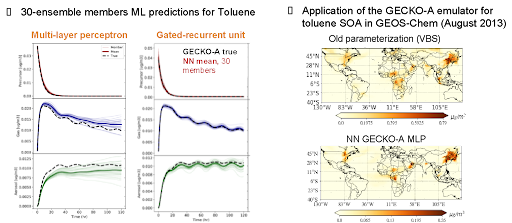Neural network emulation of the formation of organic aerosols based on an explicit chemistry model
Secondary organic aerosols (SOA) are formed from oxidation of hundreds of volatile organic compounds (VOCs) emitted from anthropogenic and natural sources. Accurate predictions of this chemistry are key for air quality and climate studies due to the large contribution of organic aerosols to submicron aerosol mass. Currently, only explicit models, such as the Generator for Explicit Chemistry and Kinetics of Organics in the Atmosphere (GECKO-A, NCAR/Univ. Paris), can fully represent the chemical processing of thousands of organic species. However, their extreme computational cost prohibits their use in current chemistry-climate models, which rely on simplified empirical parameterizations to predict SOA concentrations. Recent applications of atmospheric chemistry emulation with machine learning (ML) applied to the simpler chemical mechanisms of tropospheric ozone have shown its ability to produce realistic predictions and significantly reduce the computational cost.
In this cross-lab project (ACOM-CISL), we have shown that ML can accurately emulate SOA formation from an explicit chemistry model for several precursors with 100 to 100,000 times speedup over the explicit model GECKO-A, making it computationally usable in a chemistry-climate model. To train the ML emulator, we generated thousands of GECKO-A box simulations sampled from a broad range of initial environmental conditions, and focused on the chemistry of three representative SOA precursors: the oxidation by OH of two anthropogenic (toluene, dodecane), and one biogenic VOC (alpha-pinene). We compared fully-connected and recurrent neural network methods and used an ensemble approach to quantify their underlying uncertainty and robustness. The SOA predictions generally remained stable over a simulation period of 5 days with an approximate error of 2-8\% (left-side figure). The ML is currently being applied to within a global chemistry-climate model (right-side figure).

Figure 1. SOA ensemble members and Machine Learning with GECKO-A.